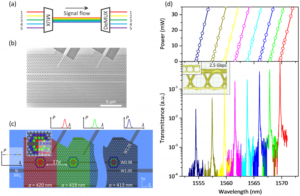ICNN2017 Tomohiro Tetsumoto
Research
ICNN 2017 Participation Report
Tomohiro Tetsumoto, 3rd year doctoral student, Tanabe Laboratory
1. Outline of the Conference
I attended ICNN2017 held from April 18 to 21. I thought that many participants would be from Japan like ALPS, but I was a little surprised to see many participants from overseas. I was satisfied to have participated in the conference because of the sumptuous food served at the reception.
2. about his/her own presentation
This time, I gave a presentation on DeMUX using photonic crystal resonators, which was mainly researched by Ooka, who graduated last year. The presentation was a bit hectic and exhausting, as we had to change the structure of the presentation late at night the day before, and I was relieved to be able to finish within the time limit, although I had to speak in a whisper due to a series of long and hard to pronounce words such as "demultiplexer. During the Q&A session, many questions were asked about specific performance issues such as drop efficiency and insertion loss, which made us realize that the performance requirements for practical research are very strict. In this presentation, I reviewed Ooka's research in detail, and I found many new improvements and design questions by putting myself in the presenter's shoes. I realized that it is effective to change one's position and think concretely when looking at other people's research.
3. topic introduction
ICNN2-1 Manipulating the Generalized Energy-bands by Nanostructure, Yidong Huang,Kaiyu Cui, Zhilei Huang
I would like to introduce on-chip Cherenkov radiation by low-energy electrons, which was discussed at the end of the lecture. Cherenkov radiation is an electromagnetic wave (light) emitted when electrons exceed the speed of light (phase velocity) in a medium. In this study, the meta-structure enables Cherenkov radiation by low-energy electrons. The key point is the use of a hyperbolic metamaterial, which is a periodic structure of layered metal and dielectric materials, so that the effective dielectric constant in the layer direction is positive and the effective dielectric constant in the traveling direction is negative. The sign reversal of the dielectric constant in the direction of travel allows electrons with velocities "below" a certain level to satisfy the conditions for Cherenkov radiation. This time, the electron energy is 0.25~1.4 keV and the wavelength is 500~900 nm, which is 2~3 orders lower than the conventional method. The details are published in Nat. Photon.
- Categories
- 国際会議報告



